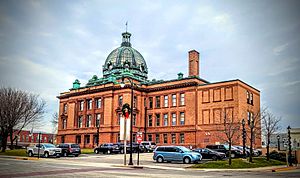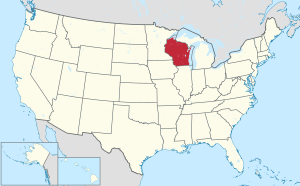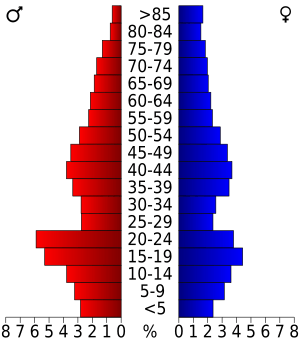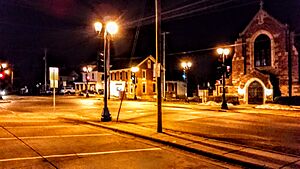Grant County, Wisconsin facts for kids
Quick facts for kids
Grant County
|
|
|---|---|

Grant County Courthouse, Armand D. Koch, architect, 1902
|
|

Location within the U.S. state of Wisconsin
|
|
 Wisconsin's location within the U.S. |
|
| Country | |
| State | |
| Founded | 1837 |
| Seat | Lancaster |
| Largest city | Platteville |
| Area | |
| • Total | 1,183 sq mi (3,060 km2) |
| • Land | 1,147 sq mi (2,970 km2) |
| • Water | 36 sq mi (90 km2) 3.1% |
| Population
(2020)
|
|
| • Total | 51,938 |
| • Estimate
(2023)
|
51,409 |
| • Density | 45.3/sq mi (17.5/km2) |
| Time zone | UTC−6 (Central) |
| • Summer (DST) | UTC−5 (CDT) |
| Congressional district | 3rd |
Grant County is a county in the southwestern part of Wisconsin, a state in the United States. In 2020, about 51,938 people lived here. The main town, called the county seat, is Lancaster. The biggest city in the county is Platteville.
The county got its name from the Grant River. This river was named after a fur trader who lived in the area a long time ago. Grant County is part of a special area called the Platteville Micropolitan Statistical Area. This means it's a smaller city area that is connected to a larger economy.
Grant County is located where three states meet: Wisconsin, Illinois, and Iowa. Many people travel through Grant County. They might be going to Madison, Wisconsin from Iowa, or heading to the Twin Cities or La Crosse, Wisconsin from northern Illinois.
Contents
History of Grant County
Early Native American Life
Before Europeans arrived, the area that is now Grant County was mostly empty. It was a border area between the lands of the Kickapoo, Menominee, and Illinois tribes. The only Native Americans who lived here permanently were the Meskwaki people. They had a temporary village in the northeast part of the county in the mid-1700s.
European Explorers and Claims
Between 1520 and 1620, Spain technically ruled this land. However, no Spanish explorers ever visited the area. The first French explorers to reach Grant County were Jacques Marquette and Louis Joliet in 1673. They explored the region but did not build any permanent settlements.
Later, in 1689, Nicholas Perrot claimed the land for the King of France. The first temporary trading post was set up by Pierre Marin in 1725. After the French and Indian War, the British took control. But they also did not settle or manage the area. An explorer from New England, Jonathan Carver, passed through in 1766. He was trying to find the Pacific Ocean.
Becoming Part of the United States
In 1783, the British government agreed that the United States owned the land east of the Mississippi River. This included what is now Grant County. For many years, American and European traders visited the area. They moved around a lot, just like the Native Americans.
Grant County was officially created in 1837. It became part of the Wisconsin Territory. The county was named after an Indian trader, but we don't know his first name or what happened to him.
Geography and Travel
Grant County covers about 1,183 square miles. Most of this area, about 1,147 square miles, is land. The rest, about 36 square miles, is water.
Main Roads
Many important roads cross Grant County:
 U.S. Highway 18
U.S. Highway 18 U.S. Highway 61
U.S. Highway 61 U.S. Highway 151
U.S. Highway 151 Highway 11 (Wisconsin)
Highway 11 (Wisconsin) Highway 35 (Wisconsin)
Highway 35 (Wisconsin) Highway 80 (Wisconsin)
Highway 80 (Wisconsin) Highway 81 (Wisconsin)
Highway 81 (Wisconsin) Highway 129 (Wisconsin)
Highway 129 (Wisconsin) Highway 133 (Wisconsin)
Highway 133 (Wisconsin)
Trains, Buses, and Airports
- Railroads:
- BNSF
- Wisconsin and Southern Railroad
- Buses:
- Platteville Public Transportation
- Airports:
- Boscobel Municipal Airport (KOVS)
- Platteville Municipal Airport (KPVB)
- Lancaster Municipal Airport (73C)
- Cassville Municipal Airport (C74)
Neighboring Counties
Grant County shares borders with these counties:
- Crawford County, Wisconsin (north)
- Richland County, Wisconsin (northeast)
- Iowa County, Wisconsin (east)
- Lafayette County, Wisconsin (east)
- Jo Daviess County, Illinois (southeast)
- Dubuque County, Iowa (south)
- Clayton County, Iowa (west)
Population and People
| Historical population | |||
|---|---|---|---|
| Census | Pop. | %± | |
| 1840 | 3,926 | — | |
| 1850 | 16,169 | 311.8% | |
| 1860 | 31,189 | 92.9% | |
| 1870 | 37,979 | 21.8% | |
| 1880 | 37,852 | −0.3% | |
| 1890 | 36,651 | −3.2% | |
| 1900 | 38,881 | 6.1% | |
| 1910 | 39,007 | 0.3% | |
| 1920 | 39,044 | 0.1% | |
| 1930 | 38,469 | −1.5% | |
| 1940 | 40,639 | 5.6% | |
| 1950 | 41,460 | 2.0% | |
| 1960 | 44,419 | 7.1% | |
| 1970 | 48,398 | 9.0% | |
| 1980 | 51,736 | 6.9% | |
| 1990 | 49,264 | −4.8% | |
| 2000 | 49,597 | 0.7% | |
| 2010 | 51,208 | 3.2% | |
| 2020 | 51,938 | 1.4% | |
| U.S. Decennial Census 1790–1960 1900–1990 1990–2000 2010–2020 |
|||
How Many People Live Here?
In 2020, the population of Grant County was 51,938 people. This means there were about 45 people living in every square mile. There were also about 22,110 homes.
Most people in the county are White (93.8%). There are also people who are Black or African American (1.3%), Asian (0.8%), and Native American (0.2%). About 2.4% of the population is Hispanic or Latino.
Towns and Villages
Grant County has several cities and many smaller towns and villages.
Cities in Grant County
- Boscobel
- Cuba City (partly in Lafayette County)
- Fennimore
- Lancaster (This is the county seat!)
- Platteville
Villages in Grant County
- Bagley
- Bloomington
- Blue River
- Cassville
- Dickeyville
- Hazel Green (partly in Lafayette County)
- Livingston (partly in Iowa County)
- Montfort (partly in Iowa County)
- Muscoda (partly in Iowa County)
- Mount Hope
- Patch Grove
- Potosi
- Tennyson
- Woodman
Unincorporated Communities
These are smaller communities that are not officially cities or villages.
- Annaton
- Arthur
- Beetown
- Bigpatch
- British Hollow
- Brodtville
- Buena Vista
- Burton
- Castle Rock
- Centerville
- Cornelia
- Diamond Grove
- Ellenboro
- Elmo
- Fair Play
- Five Points
- Flora Fountain
- Georgetown
- Hickory Grove
- Homer
- Hurricane
- Lancaster Junction
- Louisburg
- McCartney
- Millville
- Mount Ida
- North Andover
- Prairie Corners
- Preston
- Rockville
- Rutledge
- Saint Rose
- Shady Dell
- Sinsinawa
- Stitzer
- Union
- Van Buren
- Werley
- Wyalusing
Ghost Towns and Interesting Stories
Some places in Grant County used to be towns but are now gone. They are called "ghost towns."
Fair Play
Fair Play was a settlement started by a person looking for valuable minerals. Within two years, this person found ore! The settlement was built near Highway 11 and Sandy Hook Road. It was a very lively place, and arguments over money were common. The town got its name from a big fight. One person didn't have a weapon, but the other did. The crowd started yelling "Fair Play! Fair Play!" until the fight stopped. So, the town, which used to be called 'Hard Town', became 'Fair Play'. By 1846, the settlement was abandoned.
Paris
Paris was a small settlement near Dickeyville, close to Highway 151/61. It was built on the Platte River between 1838 and 1843. The person who started the town had a sickness called malaria. He named the place after his home city, Paris, France. He built the county's first bridge across the river. The founder, Detantabaritz, faced money problems. He challenged a person he owed money to a duel with swords, because he used to be a soldier. The other person backed down. Later, the founder sadly took his own life because of his money worries. Today, only a tavern remains there, selling ribs.
Notable People from Grant County
Many interesting people have come from Grant County:
- Willard H. Burney, who was a member of the Nebraska House of Representatives.
- B. W. Countryman, who was a member of the South Dakota House of Representatives.
- John Lewis Dyer, a Methodist missionary who traveled a lot. Before 1848, he worked as a lead miner in Grant County.
- William Garner Waddel, who was a member of the South Dakota Senate.
See also
 In Spanish: Condado de Grant (Wisconsin) para niños
In Spanish: Condado de Grant (Wisconsin) para niños



